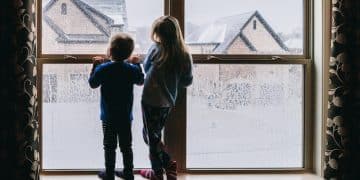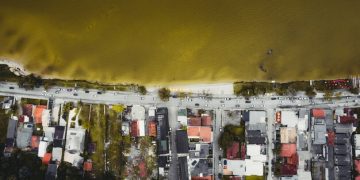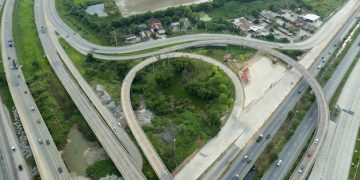Prepare for Natural Disasters in the US: A 2025 Guide

Preparing for potential natural disasters in the US in 2025 involves creating a comprehensive emergency plan, assembling a well-stocked disaster kit, staying informed about local risks, and ensuring your home is as safe as possible.
Are you ready for the unexpected? How to Prepare for Potential Natural Disasters in the US: A Step-by-Step Guide for 2025 helps you protect yourself and your loved ones from the increasing threat of natural disasters.
Understanding Natural Disaster Risks in the US
The United States faces a wide array of natural disaster risks, influenced by its diverse geography and climate. From hurricanes along the coasts to wildfires in the West, understanding these risks is the first step in effective preparedness.
Identifying Regional Threats
Each region of the US has its own unique set of vulnerabilities. It’s vital to know which disasters are most likely to occur in your area to tailor your preparation efforts effectively.
- Coastal Areas: Hurricanes, tropical storms, and coastal flooding.
- Midwest: Tornadoes, severe thunderstorms, and flooding.
- West: Wildfires, earthquakes, and droughts.
- Northeast: Blizzards, nor’easters, and ice storms.
Assessing Personal Vulnerability
Consider your individual circumstances when evaluating risk. Factors like age, health, mobility, and access to resources can significantly impact your ability to cope with a disaster.

Understanding the specific natural disaster threats in your region and your personal vulnerability is essential for crafting an effective and tailored preparedness plan. Knowledge is the first line of defense.
Building a Comprehensive Emergency Plan
An emergency plan is your roadmap for navigating a natural disaster. It outlines what to do before, during, and after an event, ensuring everyone in your household knows their roles and responsibilities.
Establish Communication Protocols
Maintain open communication amid emergencies. Consider establishing a designated out-of-state contact for family members to check in with, particularly if local communication networks are disrupted.
Evacuation Routes & Shelters
Plan multiple evacuation routes from your home and workplace. Identify nearby shelters and safe locations in advance. Practice these routes with your family to ensure everyone is familiar with them.
- Primary Route: The quickest and most direct way to safety.
- Secondary Route: An alternative in case the primary route is blocked.
- Meeting Point: A designated location outside your home where family members can gather if separated
Practice Drills and Simulations
Regularly practice your emergency plan through drills and simulations. This helps identify potential weaknesses and ensures everyone knows how to react under pressure.
Creating a comprehensive emergency plan can greatly improve your chances of staying safe during a natural disaster. It’s an investment in peace of mind and the well-being of your family.
Assembling a Well-Stocked Disaster Kit
A disaster kit is your lifeline in the aftermath of a natural disaster. It should contain essential supplies to help you survive for several days without outside assistance.
Essential Supplies Checklist
Your disaster kit should include basic necessities such as food, water, first aid supplies, and sanitation items.
Food and Hydration
Store a three-day supply of non-perishable food and water for each member of your household. Choose items that are easy to store, prepare, and consume, such as canned goods, energy bars, and bottled water.
- Non-Perishable Foods: Canned fruits, vegetables, and meats; granola bars; peanut butter.
- Water: At least one gallon per person per day.
- Manual Can Opener: Essential for accessing canned goods.
First Aid and Medical Needs
Include a comprehensive first aid kit with bandages, antiseptic wipes, pain relievers, and any personal medications you or your family members require.
A well-stocked disaster kit is an essential component of your preparedness plan. Take the time to assemble and maintain your kit to ensure you have the supplies you need when disaster strikes. Regularly check expiration dates and replace items as needed.
Staying Informed: Monitoring Weather & Emergency Alerts
Access to timely and accurate information is crucial during a natural disaster. Staying informed about weather conditions and emergency alerts can help you make informed decisions and take appropriate actions.
Utilizing Reliable Information Sources
Rely on reputable sources such as the National Weather Service (NWS), local news outlets, and emergency management agencies for weather forecasts and disaster alerts.
Weather Apps and Notifications
Download weather apps on your smartphone and enable notifications for severe weather alerts. Customize the settings to receive alerts specific to your location.

Staying informed is key to making informed decisions and taking timely actions during a natural disaster. Develop a system for monitoring weather conditions and receiving emergency alerts, ensuring you have the information you need to protect yourself and your loved ones.
Securing Your Home and Property
Taking steps to secure your home and property can reduce the risk of damage and injury during a natural disaster. Simple measures like reinforcing windows and trimming trees can make a big difference.
Home Reinforcement Techniques
Consider implementing home reinforcement techniques to protect against high winds, flooding, and earthquakes. These may include installing hurricane shutters, reinforcing garage doors, and bolting your home to its foundation.
Preparing the Exterior
Trim trees and shrubs around your home to prevent branches from falling on your roof or power lines. Secure loose objects such as patio furniture, garbage cans, and garden tools that could become projectiles in high winds.
- Window Protection: Install hurricane shutters or use plywood to cover windows.
- Garage Door Reinforcement: Reinforce garage doors to prevent them from collapsing in high winds.
Securing your home and property is a proactive step toward minimizing damage and protecting your family during a natural disaster. Take the time to assess your property’s vulnerabilities and implement measures to strengthen its defenses.
Financial Preparedness: Insurance and Documentation
Being financially prepared for a natural disaster involves having adequate insurance coverage and safeguarding important documents. Reviewing your insurance policies and creating a disaster recovery plan can help you recover more quickly after an event.
Insurance Coverage Assessment
Review your homeowner’s insurance policy to ensure it provides adequate coverage for common natural disasters in your area. Consider purchasing flood insurance if you live in a flood-prone zone.
Essential Documents Storage
Store copies of important documents such as insurance policies, identification cards, medical records, and financial statements in a waterproof and fireproof container. Keep a digital backup of these documents in a secure cloud storage account.
Financial preparedness is a critical aspect of disaster readiness. Having adequate insurance coverage and safeguarding important documents can help you recover more quickly and smoothly after a natural disaster. Take the time to review your financial situation and develop a disaster recovery plan.
Community Engagement & Support Networks
Engaging with your community and building support networks can enhance your resilience during a natural disaster. Connecting with neighbors and participating in local preparedness initiatives can provide valuable resources and assistance.
Community Emergency Response Teams (CERT)
Join your local CERT to receive training in basic disaster response skills such as first aid, search and rescue, and fire suppression. This will enable you to assist your community during emergencies.
Neighborhood Watch Programs
Participate in your neighborhood watch program to enhance communication and cooperation among residents. Work together to identify hazards, share resources, and support vulnerable neighbors.
Community engagement and support networks are vital components of disaster preparedness. By connecting with your neighbors and participating in local preparedness initiatives, you can strengthen your community’s resilience and ensure everyone is better prepared to face natural disasters.
| Key Point | Brief Description |
|---|---|
| ⚠️ Emergency Plan | Establish communication, evacuation routes, and practice drills. |
| 🎒 Disaster Kit | Stock non-perishable food, water, first aid, and essential supplies. |
| 📡 Stay Informed | Monitor weather alerts via NOAA, local news, and weather apps. |
| 🏠 Secure Home | Reinforce structures, trim trees, and secure outdoor items. |
Frequently Asked Questions (FAQ)
▼
The first step is to understand the specific types of natural disasters that are most likely to occur in your area. This will help you tailor your preparedness efforts effectively.
▼
You should aim to store at least one gallon of water per person per day for a minimum of three days. Consider storing more if you have the space.
▼
Include bandages, antiseptic wipes, pain relievers, gauze pads, medical tape, scissors, and any personal medications you or your family members require.
▼
Monitor weather alerts and warnings through the National Weather Service (NWS), local news outlets, and weather apps on your smartphone. Enable notifications for severe weather alerts.
▼
A family emergency plan ensures everyone knows what to do before, during, and after a disaster. It outlines communication protocols, evacuation routes, and meeting points.
Conclusion
Preparing for potential natural disasters in the US is a continuous process that requires ongoing vigilance and adaptation. By understanding your risks, building a comprehensive emergency plan, assembling a well-stocked disaster kit, staying informed, and securing your home, you can significantly enhance your resilience and protect yourself and your loved ones from the impacts of natural disasters.






